Beckman Purisima and summer grills
 |
| Steve Beckman |
I could see for miles and miles at the top of the Purisima Mountain Vineyard, owned and farmed by Steve Beckman of Santa Barbara’s Beckman Vineyards. But the “truth,” according to Beckman, is not “out there,” but in the soil, the grapes, and in the resulting wine; no matter what you may think of the Biodynamic® practices they have been practicing full-on since 2006.
The Beckmans (Steve the vigneron, with his parents Tom and Judy) purchased their 365 acre mountain estate in the mid-section (unofficially called Ballard Canyon) of Santa Ynez Valley in 1996, just a couple of years after establishing their winery on a 20 acre vineyard parcel just over the hill, a couple of hairpin turns away.
Vintages from the late ‘90s, produced from grapes from neighboring properties (like the prestigious Stolpman Vineyards) convinced the Beckmans that Syrah and Grenache – yielding ultra-deep and concentrated wines when grown in the shallow, sandy clay layered over mounds of calcareous rock, surfacing towards the tops of these hillsides -- were the way to go with their own plantings.
Steve was first exposed to biodynamics by a college friend and backyard gardener in 1995, but it would be another four years, after meeting a Frenchman named Philippe Armenier (of Domaine de Marcoux in Châteauneuf-du-Pape), before his own skepticism turned the corner to healthy curiosity. The initial decision, according to Beckman, “was the hardest.” But with Armenier’s advisory, 17 trial acres of 100% biodynamically farmed Syrah, planted on Purisima in 2001, turned up “immediate results.”
 Beckman saw “plants that wanted to grow straight up to the sun instead of in all directions,” and “when we brought in the fruit, we saw increased nutrients in our musts and healthier fermentations.” When comparing their Biodynamic® vs. conventionally grown wines, Beckman discovered “wines that I loved… wines that I thought expressed what the terroir of Purisima was about: rich, ripe wines that are balanced and elegant.”
Beckman saw “plants that wanted to grow straight up to the sun instead of in all directions,” and “when we brought in the fruit, we saw increased nutrients in our musts and healthier fermentations.” When comparing their Biodynamic® vs. conventionally grown wines, Beckman discovered “wines that I loved… wines that I thought expressed what the terroir of Purisima was about: rich, ripe wines that are balanced and elegant.” Thereafter, the decision was easy; and the Beckmans converted all 125 of their planted acres on Purisima to Biodynamic®.
As we drove by his home in the middle of vineyard, Beckman stopped to give his four year old son a hug, and related this story: “No question, our soils our richer, our roots are growing vertically, and earthworms are a lot happier with what we’re doing. But what really reinforced our conviction that we’re doing the right thing is when my son recently saw some workers in a nearby vineyard wearing chemical suits, and he turned to me and asked, ‘Dad, why are they spraying poison on their grapes?’ So you see why, to me, it’s not biodynamics that are out of whack. It’s the industrial, chemical-based concepts that make no sense at all.”
 The Rhône inspired wines of Beckman Vineyards have always been top-notch; and with the recent return of Hawai`i born winemaker Mikael Sigouin (who also produces his own outstanding Rhône style blends under the Kaena label) after a brief hiatus with another winery, this brand is now truly rocking and rolling; as evidenced by a tasting of their top-of-the-line Grenache/Syrah (60%/40%) blend, the 2005 Beckman Santa Ynez Valley Purisima (about $75).
The Rhône inspired wines of Beckman Vineyards have always been top-notch; and with the recent return of Hawai`i born winemaker Mikael Sigouin (who also produces his own outstanding Rhône style blends under the Kaena label) after a brief hiatus with another winery, this brand is now truly rocking and rolling; as evidenced by a tasting of their top-of-the-line Grenache/Syrah (60%/40%) blend, the 2005 Beckman Santa Ynez Valley Purisima (about $75). Purisima is produced only once every two or three years, when vintage conditions are optimal; and I can see why the ’05 made the cut: it’s massive – a burly yet round, sleek, fleshy concentration of red berries and pomegranate, spiked with smoke and peppercorn; and despite a monumental structure of meat and tannin, the sweet sensation in the middle and finish is very much of dark chocolate covered strawberries, consumed with long, supple, black leather gloves.
Doesn’t take a culinary genius to know what food matches this kind of sick bruiser: grilled meats, especially strewn with cracked pepper and sweet/spicy seasonings or rubs. But don’t limit yourself. I like what William Lengeman III says in this intro to Grilling 101: summer grilling often conjures images of testosterone-addled men wrestling slabs of meat, but let’s consider another eminently grillable foodstuff… the vegetable. And when you apply marinades and foils, even pedestrian mushrooms and root vegetables can be hot.



Comments
Post a Comment